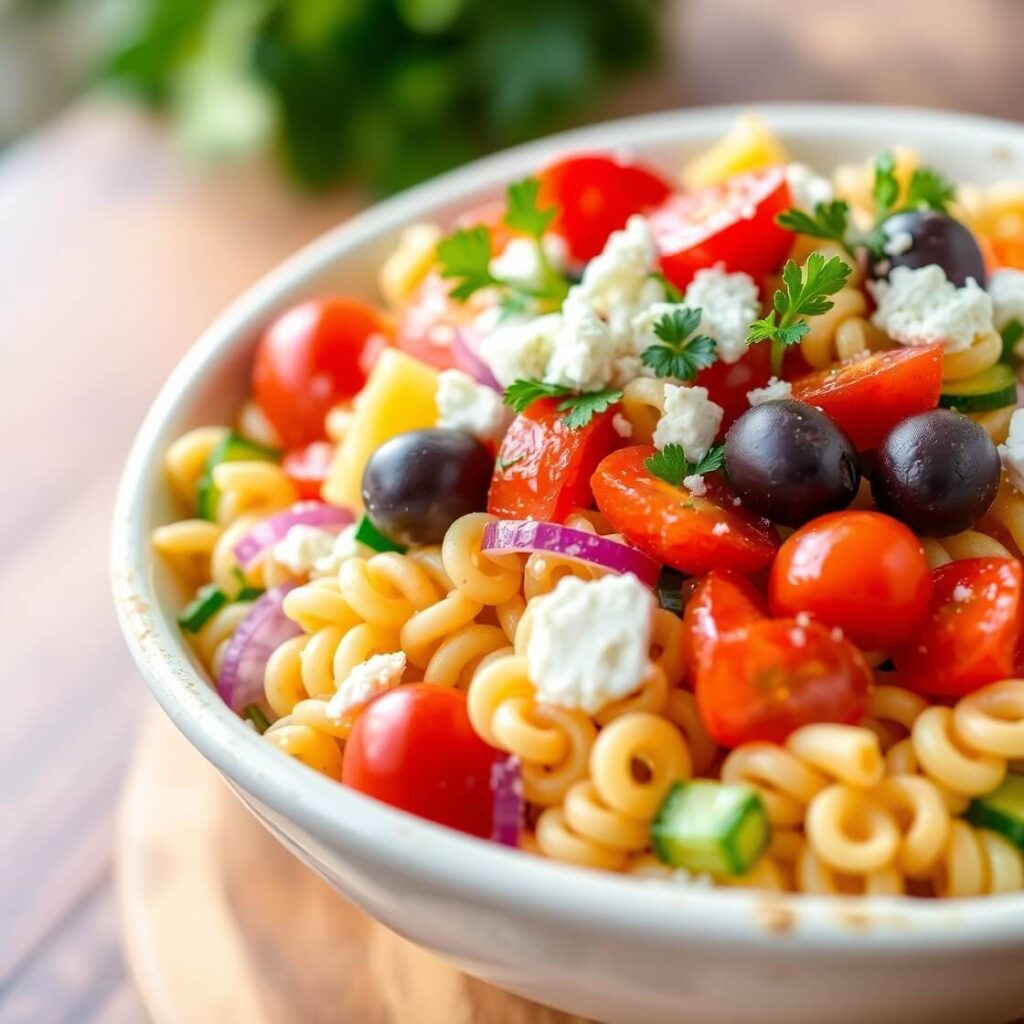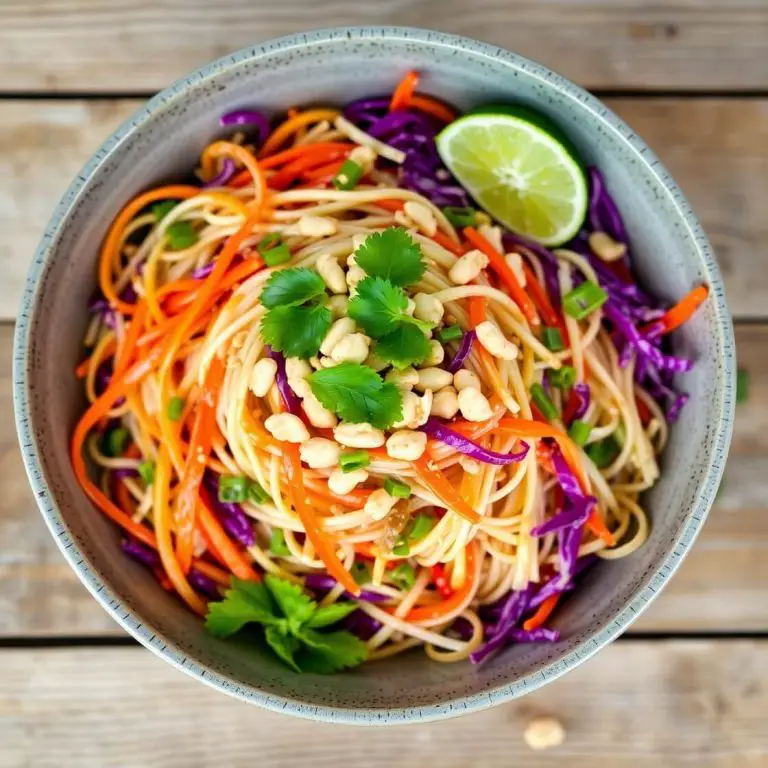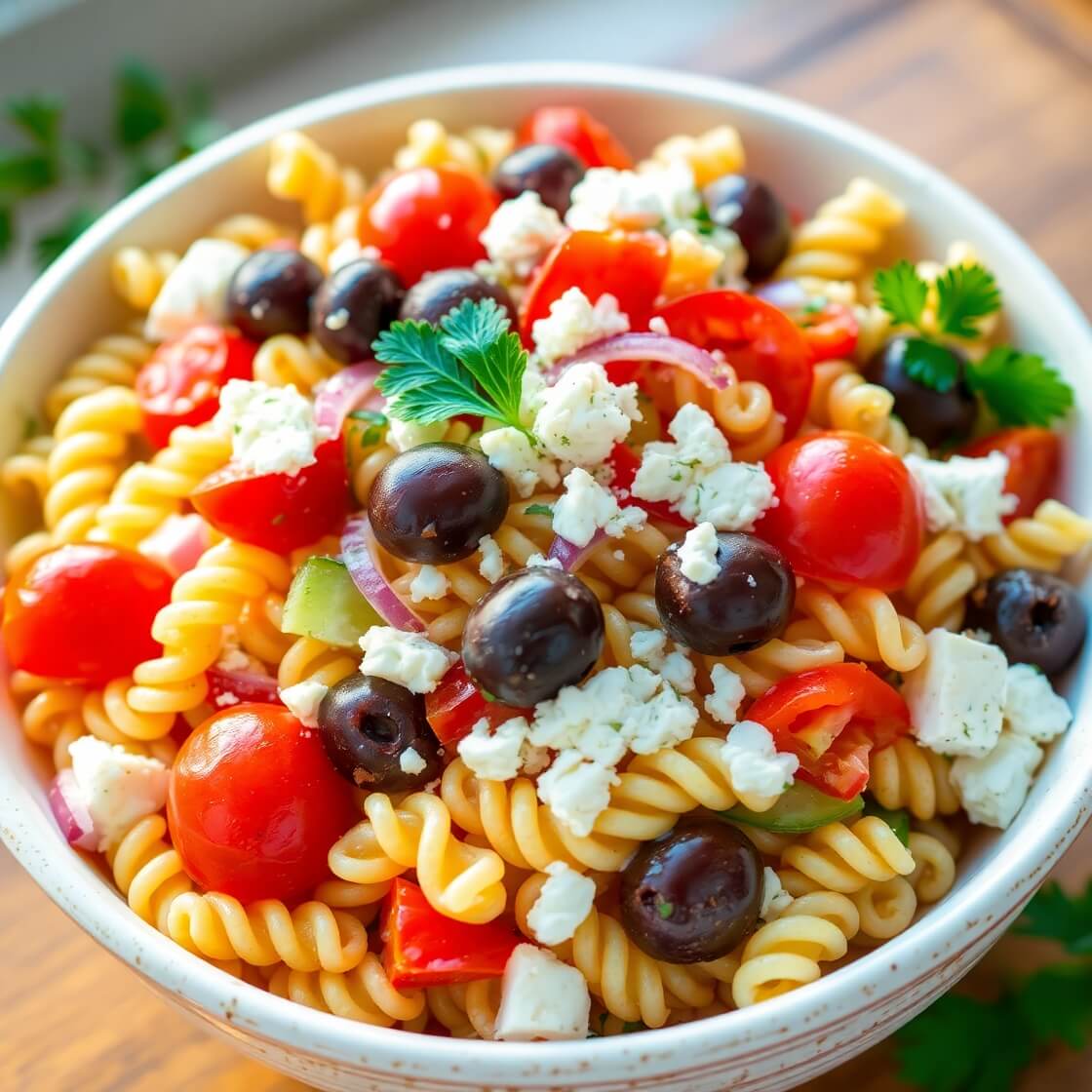
Greek pasta salad is one of those dishes that effortlessly brings together the fresh, vibrant flavors of the Mediterranean in a bowl. I first made this recipe on a warm summer afternoon when I wanted something light, satisfying, and packed with colorful ingredients. It quickly became a favorite in my home and among friends because it’s not only delicious but also incredibly easy to prepare. If you’re searching for a refreshing salad that can double as a main dish or a perfect side, this Greek pasta salad recipe might just become your new go-to. Stick around, and I’ll share how to make this simple yet flavorful salad that will brighten any meal.
Why I Love This Recipe
There’s something special about this Greek pasta salad that makes it stand out. It’s the perfect harmony of textures and flavors — tender pasta, crisp cucumbers, juicy tomatoes, briny olives, and tangy feta cheese, all tossed in a zesty lemon-oregano dressing. This salad is a celebration of fresh ingredients, bringing together the heartiness of pasta with the lightness of classic Greek salad elements.
What really draws me to this recipe is its versatility. Whether you’re preparing a quick lunch, a picnic, or a side for a summer barbecue, this salad fits right in. It’s also a fantastic way to use up vegetables you might have on hand, making it adaptable and practical.
Moreover, it’s a dish that looks as good as it tastes. The vibrant colors make it appealing and inviting, perfect for serving to guests or for meal prepping during the week. And the best part? It tastes even better the next day after the flavors have had time to mingle.
Ingredients for Greek Pasta Salad
To make this recipe, you’ll want to gather some simple, fresh ingredients. Here’s a rundown of what you’ll need:
- Pasta: I recommend using short pasta shapes like rotini, penne, or fusilli. They hold onto the dressing and ingredients beautifully.
- Vegetables: Classic Greek salad veggies shine here — cucumbers, cherry or grape tomatoes, red onions, and bell peppers add crunch and sweetness.
- Olives: Kalamata olives bring that signature briny bite that makes this salad so authentic.
- Cheese: Crumbled feta cheese adds a creamy, salty contrast to the crisp veggies.
- Fresh herbs: Fresh parsley or oregano elevate the salad with a burst of herbal freshness.
- Dressing ingredients: Olive oil, lemon juice, red wine vinegar, garlic, dried oregano, salt, and pepper create a tangy, bright dressing that ties everything together.
These ingredients are easy to find, and many of them might already be in your kitchen. Their freshness and quality will make a huge difference, so I always suggest choosing the best you can get.
How Much Time Will You Need
One of the reasons this recipe is so approachable is how quickly it comes together.
- Prep time: About 15 minutes to chop vegetables and cook the pasta.
- Cook time: Around 10 minutes for boiling the pasta.
- Resting time: While optional, letting the salad chill in the fridge for at least 30 minutes allows the flavors to meld beautifully.
In total, you’re looking at about 40 to 45 minutes from start to finish. It’s a great recipe when you want something fresh and homemade but don’t want to spend hours in the kitchen.
How to Make This Greek Pasta Salad
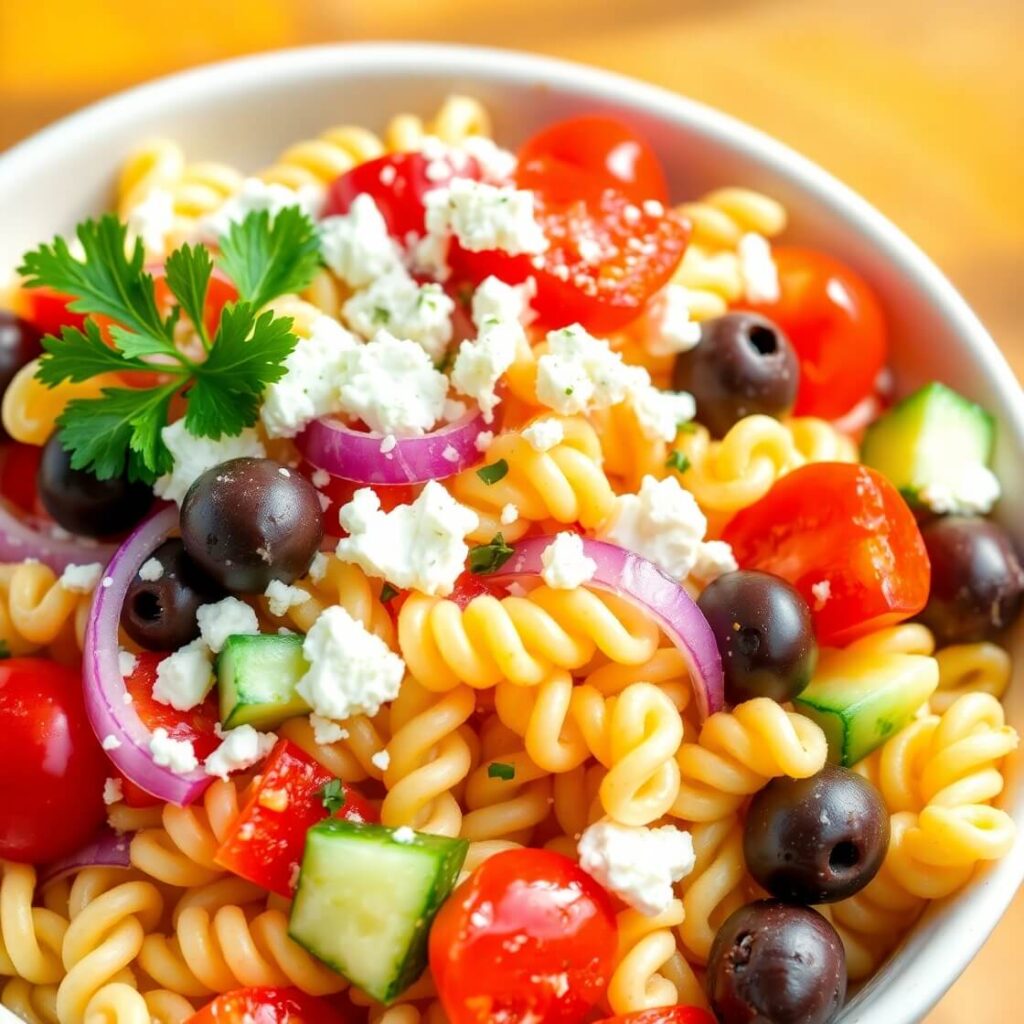
Here’s a step-by-step guide to making this tasty Greek pasta salad. I’ll walk you through every detail to make sure you get it just right.
Step 1: Start by boiling a large pot of salted water. Once it’s boiling, add your pasta (I like rotini or penne for this). Cook according to the package instructions until al dente — meaning tender but still slightly firm to the bite.
Step 2: While the pasta cooks, prep your vegetables. Wash and halve the cherry tomatoes, dice the cucumber into bite-sized pieces, thinly slice the red onion, and chop the bell peppers.
Step 3: When the pasta is done, drain it well and rinse briefly under cold water to stop the cooking process and cool it down. This also helps prevent the pasta from sticking together.
Step 4: In a large mixing bowl, combine the cooled pasta with the prepared vegetables, kalamata olives (pitted and halved if you prefer), and crumbled feta cheese.
Step 5: Make the dressing by whisking together olive oil, freshly squeezed lemon juice, red wine vinegar, minced garlic, dried oregano, salt, and freshly ground black pepper. Adjust seasoning to your taste — you want a nice balance of tangy and savory.
Step 6: Pour the dressing over the pasta and vegetables. Toss everything gently but thoroughly to coat the salad evenly with the dressing.
Step 7: Sprinkle chopped fresh parsley or oregano on top for a final touch of freshness.
Step 8: Cover the salad and refrigerate for at least 30 minutes. This resting time allows the flavors to meld beautifully, making each bite burst with Mediterranean goodness.
Substitutions
One of the joys of this Greek pasta salad is its flexibility. Here are some ideas to tweak it to your liking or based on what you have in your kitchen:
- If you don’t have feta, try substituting with goat cheese or a sharp white cheese for a similar tang.
- For olives, if Kalamata aren’t available, black olives or green olives can work, but they’ll change the flavor slightly.
- You can swap pasta for couscous or quinoa to make it gluten-free or add a different texture.
- Instead of lemon juice, some like to use extra red wine vinegar or even a splash of balsamic vinegar for a different acidic note.
- If you prefer a bit more protein, adding grilled chicken, chickpeas, or even tuna can make the salad more filling.
- For a more herbaceous twist, adding fresh mint or dill can give the salad a new flavor dimension.
Best Side Dishes for Greek Pasta Salad
While this Greek pasta salad can stand on its own, pairing it with the right side dishes can elevate your meal. Here are three that complement it beautifully:
- Grilled lemon herb chicken: The smoky, citrusy flavors pair perfectly with the fresh salad.
- Warm pita bread with tzatziki: Soft pita and creamy cucumber-yogurt dip make a great contrast.
- Roasted Mediterranean vegetables: Think eggplant, zucchini, and bell peppers drizzled with olive oil and herbs — these warm veggies add heartiness.
Serving and Presentation Tips
Greek pasta salad is naturally vibrant and colorful, so presentation is all about showcasing those fresh ingredients beautifully. To serve, use a wide, shallow bowl so the salad spreads out, allowing guests to see the mix of reds, greens, purples, and whites.
Garnish the top with a sprinkle of fresh herbs like parsley or oregano to add a pop of green. You can also add a few whole olives or a small wedge of lemon on the side for visual interest and extra zest.
For individual servings, consider using small glass jars or bowls that show off the layers of pasta, veggies, and cheese—perfect for picnics or casual entertaining. Drizzle a little extra dressing over the salad right before serving to keep everything glossy and appetizing.
Serving the salad chilled enhances the refreshing qualities, especially on warm days, so keep it refrigerated until ready to serve.
Tips and Tricks to Make This Recipe Even Better
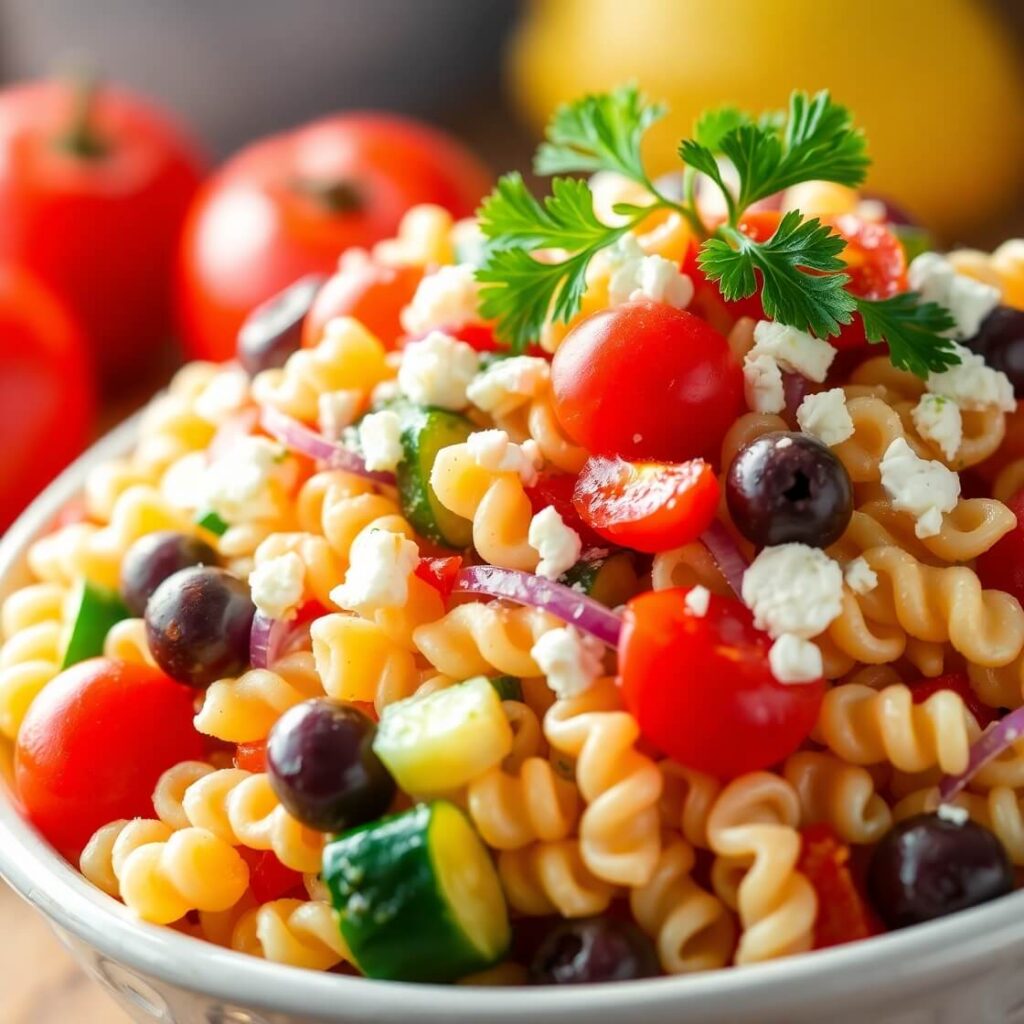
To elevate this Greek pasta salad, here are some helpful tips I’ve learned over time:
- Cook pasta just right: Al dente pasta holds its shape and texture better when tossed with dressing and vegetables. Avoid overcooking to keep the salad from becoming mushy.
- Use high-quality olive oil: Since olive oil is a key part of the dressing, choose one that’s extra virgin and flavorful—it makes a big difference.
- Chill for flavor melding: Letting the salad rest for at least 30 minutes (or longer) in the fridge allows all the flavors to combine beautifully.
- Add a touch of sweetness: A small pinch of sugar or a drizzle of honey in the dressing balances the acidity and enhances the overall flavor.
- Toast your herbs: Lightly toasting dried oregano before mixing it into the dressing can bring out its aroma and flavor.
- Customize texture: If you love crunch, add toasted pine nuts or slivered almonds as a topping.
- Fresh lemon zest: Adding lemon zest to the dressing brightens the flavor without extra acidity.
Common Mistakes to Avoid
Making this Greek pasta salad is straightforward, but a few common pitfalls can affect the final result:
- Overcooking the pasta: This makes the salad soggy and mushy. Always cook pasta to al dente and rinse with cold water.
- Using too much dressing: Overdressing can make the salad watery and overpower the fresh ingredients. Add dressing gradually and toss lightly.
- Skipping the chilling time: Serving the salad immediately after mixing doesn’t allow flavors to meld properly. Patience here pays off.
- Not salting the pasta water: This is essential for seasoning the pasta itself; without it, the salad may taste bland.
- Cutting vegetables too large or unevenly: For an even bite and better presentation, chop ingredients into similar, bite-sized pieces.
How to Store It
Greek pasta salad keeps well in the refrigerator for up to 3 days, making it perfect for meal prep or leftovers.
Store it in an airtight container to preserve freshness and prevent odors from other foods from mingling.
If you plan to keep it longer, store the dressing separately and toss the salad right before serving to avoid sogginess.
Before serving leftovers, give the salad a gentle toss and, if needed, add a splash of fresh lemon juice or olive oil to revive the flavors.
Avoid freezing this salad as the fresh vegetables and cheese will lose their texture and become watery when thawed.
Frequently Asked Questions
Can I make this Greek pasta salad ahead of time?
Yes, it actually tastes better after resting for a few hours or overnight in the fridge. Just store it in an airtight container.
What type of pasta works best?
Short, sturdy pasta shapes like rotini, penne, or fusilli hold dressing well and work best in this salad.
Can I make this recipe gluten-free?
Absolutely! Swap regular pasta for gluten-free pasta or even use quinoa or couscous as alternatives.
Is this recipe suitable for vegans?
Traditional Greek pasta salad includes feta cheese, which is not vegan. However, you can replace feta with vegan cheese or omit it altogether.
How long does this salad keep in the fridge?
It’s best consumed within 3 days for optimal freshness and flavor.

Greek Pasta Salad Recipe
- Total Time: 40 minutes (including chilling)
- Yield: 4-6 1x
- Diet: Vegetarian
Description
Greek Pasta Salad is a bright, fresh, and colorful salad combining tender pasta with classic Greek ingredients like cucumbers, tomatoes, olives, and feta cheese, all tossed in a tangy lemon-oregano dressing. Perfect for summer lunches, potlucks, or light dinners, it’s easy to prepare and even better when chilled. This salad brings Mediterranean flavors to your table with a balance of crunchy veggies, creamy cheese, and zesty dressing.
Ingredients
- 8 oz (about 2 cups) rotini or penne pasta
- 1 cup cherry or grape tomatoes, halved
- 1 medium cucumber, diced
- 1/2 red onion, thinly sliced
- 1 bell pepper (any color), diced
- 1/2 cup kalamata olives, pitted and halved
- 1 cup crumbled feta cheese
- 2 tablespoons fresh parsley or oregano, chopped
2 .For the dressing:
- 1/4 cup extra virgin olive oil
- 3 tablespoons freshly squeezed lemon juice
- 1 tablespoon red wine vinegar
- 1 garlic clove, minced
- 1 teaspoon dried oregano
- Salt and freshly ground black pepper, to taste
Instructions
- Cook pasta in salted boiling water until al dente. Drain and rinse with cold water.
- Prepare vegetables: halve tomatoes, dice cucumber and bell pepper, thinly slice onion.
- In a large bowl, combine pasta, vegetables, olives, and feta.
- Whisk dressing ingredients until emulsified.
- Pour dressing over salad and toss gently to combine.
- Garnish with fresh herbs.
- Refrigerate at least 30 minutes before serving.
Notes
- Taste the dressing before tossing to adjust acidity or seasoning.
- Add a pinch of sugar or honey if you want to balance acidity.
- For extra crunch, sprinkle toasted pine nuts before serving.
- Prep Time: 15 minutes
- Cook Time: 10 minutes
- Category: Salad
- Method: Boiling, No-cook assembly
- Cuisine: Mediterranean / Greek
Nutrition
- Serving Size: 4-6
- Calories: 320
- Sugar: 5g
- Sodium: 480mg
- Fat: 18g
- Saturated Fat: 6g
- Unsaturated Fat: 12g
- Trans Fat: 0g
- Carbohydrates: 30g
- Fiber: 3g
- Protein: 9g
- Cholesterol: 20mg

